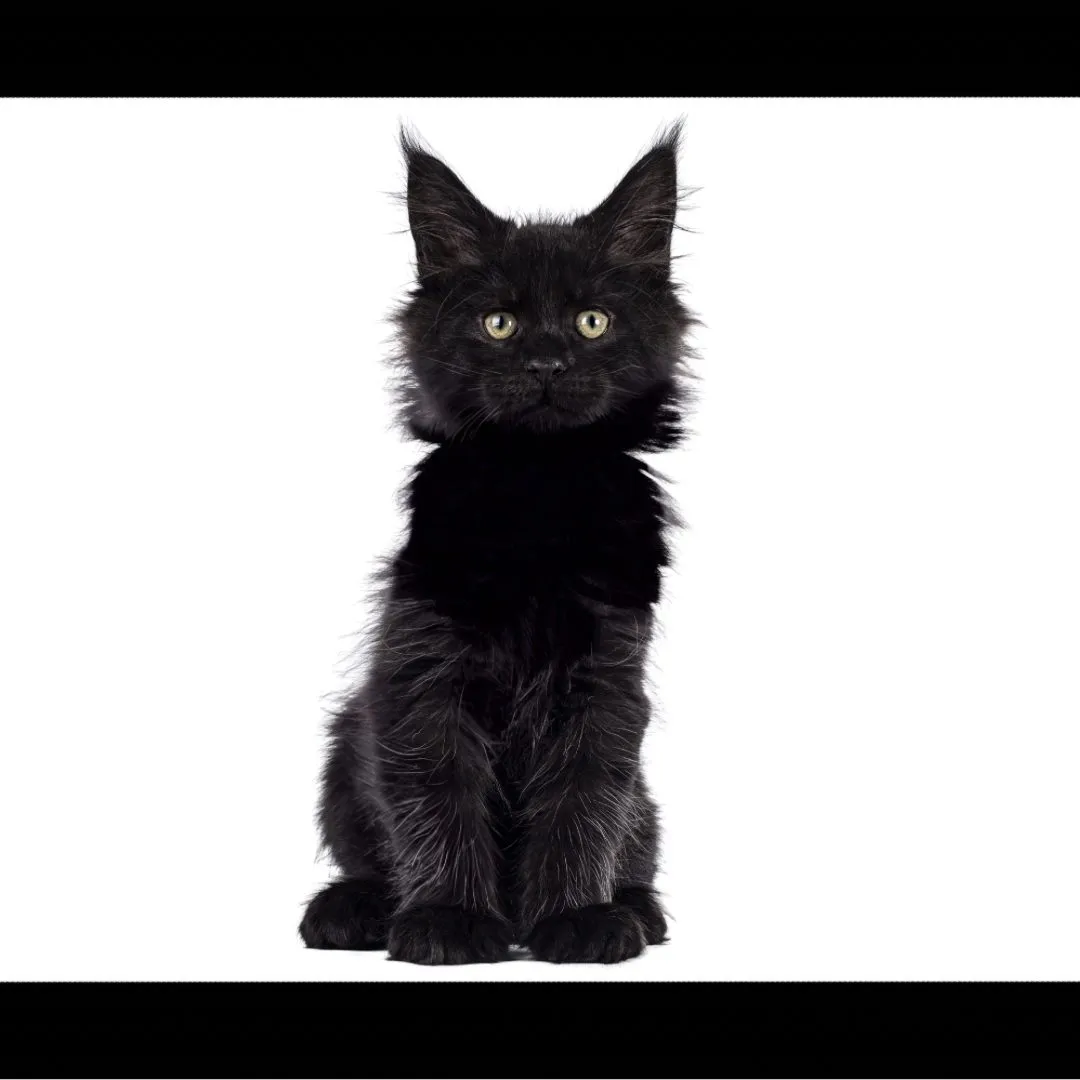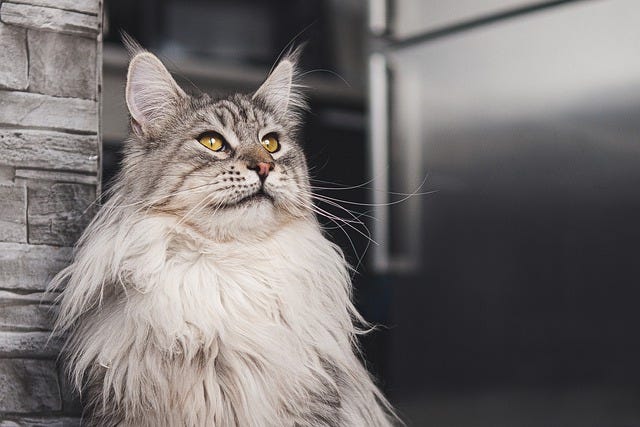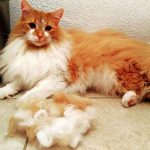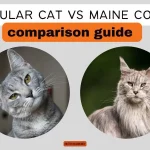Why are Maine Coons So Big? Unraveling the Secrets Behind Their Massive Size
Maine Coons are big cats due to a combination of genetics and the environment they live in. Their large size is a result of their lineage, as they descend from Norwegian Forest Cats.
Additionally, factors such as natural selection favoring bigger cats with thicker fur may have contributed to their size. Maine Coons’ size is a unique characteristic that sets them apart from other cat breeds, making them known as the “gentle giants” of the feline world.
These cats have a gentle disposition, are very vocal, and are relatively easy to train, making them a popular choice among cat lovers. Their large size is not only visually impressive but also adds to their unique and special qualities.
The Origins Of Maine Coon Cats’ Massive Size
The Maine Coon is one of the largest domesticated cat breeds in the world. Known for their impressive size and majestic appearance, many have wondered about the reasons behind their massive stature. In this article, we explore the origins of Maine Coon cats’ massive size and uncover the factors that contribute to their impressive growth.
The Historical Connection Between Maine Coon Cats And The Turkish Angora Cats
One possible explanation for the Maine Coon’s large size lies in its historical connection with Turkish Angora cats. It is believed that six Turkish Angoras, cats renowned for their beauty and elegance, found their way to Maine aboard the ship of Marie Antoinette during the French Revolution. Upon reaching land, these Angora cats are said to have cross-bred with local short-haired cats, resulting in the development of what we now know as the Maine Coon.
The Influence Of Cross-breeding With Local Short-haired Cats
The cross-breeding between Turkish Angora cats and local short-haired cats played a significant role in shaping the size of Maine Coons. By introducing genes from the Turkish Angora breed, which is naturally larger in size, the resulting offspring inherited certain physical traits, including their larger stature. Over generations, this cross-breeding contributed to the Maine Coon’s continued growth and size enhancement.
The Role Of Natural Selection In Favoring Bigger Cats
Another factor that contributed to the Maine Coon’s massive size is natural selection. Over time, the harsh New England climate and terrain necessitated the development of cats with bigger bodies and thicker fur to withstand the unforgiving winters. Through natural selection, larger Maine Coons with better survival abilities and increased hunting prowess were favored, leading to the continuation of their larger size through successive generations.
In conclusion, the massive size of Maine Coon cats can be attributed to a combination of factors. Their historical connection with Turkish Angora cats and the influence of cross-breeding with local short-haired cats played a significant role in shaping their large stature. Additionally, natural selection favored bigger cats with thicker fur, ensuring their survival in the harsh New England environment. Together, these factors contribute to the impressive size of Maine Coon cats, making them one of the most majestic and beloved breeds in the feline world.

Credit: kritterkommunity.com
Physical Characteristics That Contribute To Their Size
Maine Coons are known to be exceptionally large cats due to a combination of genetics and environment. They are believed to have descended from Norwegian Forest Cats and their size has been favored by natural selection, making them formidable predators with thick fur.
Understanding The Genetic Makeup Of Maine Coon Cats
Maine Coon cats are renowned for their impressive size, often weighing between 15 to 25 pounds. Understanding the genetic makeup of these feline giants can shed some light on the reasons behind their substantial stature. Maine Coons are believed to have descended from Norwegian Forest Cats, which were introduced to the northeastern United States centuries ago. These cats developed unique genetic traits that enabled them to thrive in the harsh Maine climate. Over time, they interbred with local short-haired cats, resulting in the distinctive Maine Coon we know today.The Role Of Bone Structure And Musculature
One of the major physical characteristics that contribute to the size of Maine Coon cats is their bone structure and musculature. These cats have a sturdy skeletal system with large, strong bones. Their long bodies and muscular build give them a robust and muscular appearance, adding to their overall size. The bones of Maine Coons are well-developed and contribute to their impressive stature. Their dense bones provide excellent support for their large bodies, making them stand out among other cat breeds. Additionally, their powerful musculature allows them to move with grace and agility despite their large size.Coat Density And Its Impact On Perceived Size
Another factor that contributes to the perceived size of Maine Coon cats is their coat density. Maine Coons have a thick, double-layered coat that provides insulation and protection against the elements. This luxurious coat can make them appear even larger than they actually are. The outer layer of their coat is long and water-resistant, while the undercoat is dense and plush. This combination not only keeps them warm in cold weather but also adds bulk to their body. As a result, Maine Coons can appear larger and more imposing than other cat breeds with similar body measurements. In conclusion, the physical characteristics of Maine Coon cats that contribute to their large size include their genetic makeup, bone structure, musculature, and coat density. These traits work in concert to create the impressive stature that has come to define this breed. So, next time you see a magnificent Maine Coon, you’ll have a better understanding of why they are so big.Factors Influencing The Growth And Development Of Maine Coon Cats
Maine Coon cats are known for their large size due to a combination of genetics and environment. They have descended from Norwegian Forest cats and their lineage as wild cats has contributed to their naturally big size.
Slow Maturation Process And Its Effects On Size
Maine Coon cats are renowned for their impressive size, often being referred to as the “gentle giants” of the cat world. One factor that contributes to their large stature is their slow maturation process. Unlike other cat breeds, Maine Coons take longer to reach full physical development.
This slow maturation process can be attributed to their genetic makeup and ancestral history. Maine Coons are believed to directly descend from Norwegian Forest Cats, which were known for their size and robustness. Through natural selection, the larger and more well-adapted cats were able to survive and reproduce, passing on their genes for increased size to future generations of Maine Coons.
The slow maturation process of Maine Coons allows their bodies to gradually grow and develop, giving them the opportunity to reach their full potential in terms of size and stature. This prolonged growth period results in Maine Coons being one of the largest domestic cat breeds.
The Impact Of Nutrition And Diet On Growth
The growth and development of Maine Coon cats can also be influenced by their diet and nutrition. Providing a balanced and nutritious diet is crucial for their overall well-being, including their size and physical development.
Maine Coons have a higher metabolism compared to other cat breeds, which means they require more calories and nutrients to support their growth. A diet rich in high-quality protein from sources such as meat and fish is essential to promote muscle development and overall growth.
In addition to protein, Maine Coons also benefit from a diet that includes fats and carbohydrates in appropriate proportions. Fats provide essential fatty acids that aid in coat health and maintain energy levels, while carbohydrates provide a source of energy for their active lifestyle.
Role Of Proper Healthcare And Regular Veterinary Check-ups
Proper healthcare and regular veterinary check-ups play a significant role in ensuring the growth and development of Maine Coon cats. Regular visits to the veterinarian allow for early detection of any potential health issues that may hinder their growth.
During veterinary check-ups, professionals can assess the overall health and well-being of Maine Coons, including monitoring their weight and growth progress. They can also provide advice on appropriate nutrition and diet, as well as recommend any necessary supplements to support their growth.
Additionally, regular vaccinations and preventive care measures, such as deworming and parasite control, are crucial for maintaining their overall health and preventing any setbacks in growth and development.
Comparing Maine Coons To Other Cat Breeds
When it comes to size, Maine Coon cats are in a league of their own. Known as the gentle giants of the cat world, these majestic felines have a reputation for their impressive size. But how do they measure up against other cat breeds? Let’s explore how Maine Coons compare to different cat breeds in terms of their size and proportions.
Maine Coon Cats Vs. Norwegian Forest Cats: A Common Ancestry
Maine Coons and Norwegian Forest Cats share a common ancestry, which explains why they often have similar characteristics, including their large size. Both breeds originated from wild cats that lived in harsh climates, adapted for survival in the cold and snowy regions of the world. The Norwegian Forest Cats, as their name suggests, hail from the forests of Norway, while Maine Coons were developed in the state of Maine. These cats are believed to have descended from Norwegian Forest Cats that were brought to Maine by early settlers.
How Maine Coons Measure Up Against Other Large Domestic Cat Breeds
While Maine Coons and Norwegian Forest Cats may share a common ancestry, Maine Coons are generally larger in size compared to other domestic cat breeds. They are known to be one of the largest domestic cat breeds globally. Let’s take a look at some other popular large cat breeds and how they compare to Maine Coons.
Siberian Cats:
- Siberian Cats are another breed that shares a resemblance to Maine Coons in terms of their size and proportions.
- Although they are not as big as Maine Coons on average, Siberian Cats can still grow to be quite large and have a muscular build.
- However, Maine Coons tend to have a more substantial frame and generally outweigh Siberian Cats.
Ragdoll Cats:
- Ragdoll Cats are known for their placid temperament and beautiful blue eyes, but when it comes to size, they fall behind Maine Coons.
- Maine Coons typically outweigh Ragdoll Cats and have a more robust stature.
- While Ragdolls are undoubtedly large cats, they don’t quite reach the impressive size of Maine Coons.
Examining Size Differences Between Male And Female Maine Coon Cats
It’s important to note that there can be differences in size between male and female Maine Coon cats. Male cats are generally larger and more muscular compared to females. Here’s a comparison of the size differences:
| Size Category | Male Maine Coons | Female Maine Coons |
|---|---|---|
| Weight | 15-25 pounds (6.8-11.3 kg) | 10-15 pounds (4.5-6.8 kg) |
| Length | 40-48 inches (101.6-121.9 cm) | 32-40 inches (81.3-101.6 cm) |
As you can see, male Maine Coons are significantly larger and heavier than their female counterparts. This size difference adds to the overall grandeur and presence that Maine Coons possess.
Debunking Common Myths About Maine Coon Cats’ Size
Debunking Common Myths About Maine Coon Cats’ Size
Addressing Misconceptions About The Use Of Steroids Or Artificial Means To Enhance Size
There is a common misconception that Maine Coon cats are so big because of the use of steroids or other artificial means to enhance their size. However, this is completely false and has no basis in reality. Maine Coons are naturally large cats, and their size is not artificially manipulated by breeders.
Maine Coons have a unique genetic makeup that contributes to their large size, and their growth is not influenced by external factors like steroids. It’s important to note that using steroids or any other artificial methods to enhance a cat’s size would be unethical and harmful to the animal’s health.
Understanding The Natural Genetic Predisposition For Larger Size
Maine Coons have a natural genetic predisposition for larger size. They are descendants of Norwegian Forest Cats, which are known for their robust build and substantial size. Over time, these traits have been passed down through generations, resulting in the impressive size of the Maine Coon breed.
Their genetic makeup includes factors that contribute to their larger stature, such as a larger skeletal structure, longer limbs, and more muscle mass. These genetic characteristics play a significant role in the overall size of the Maine Coon, making them one of the largest domestic cat breeds.
Highlighting The Importance Of Responsible Breeding Practices In Maintaining Size Standards
Responsible breeding practices play a vital role in maintaining the size standards of Maine Coons. Ethical breeders focus on preserving the natural size traits of the breed by selectively breeding cats with the desired characteristics.
By carefully selecting breeding pairs based on their size and lineage, responsible breeders ensure that the size standards of Maine Coons are upheld. This helps to prevent the dilution of the breed’s natural genetic predisposition for larger size.
Additionally, responsible breeders prioritize the health and well-being of their cats over size alone. They take into consideration other important factors, such as temperament, overall health, and adherence to breed standards, to ensure that the cats they produce are not only big but also healthy and well-balanced individuals.
Frequently Asked Questions For Why Are Maine Coons So Big
Are All Maine Coon Cats Really Big?
Maine Coon cats are not all big. Their size can vary due to genetics and environment. They descend from Norwegian Forest Cats and can grow larger if they have a genetic predisposition. However, their size should not be the only factor to judge them as they have wonderful personality traits.
What 2 Breeds Make A Maine Coon?
The Maine Coon breed is a result of breeding between Turkish Angora cats and local short-haired cats.
What Is So Special About Maine Coons?
Maine Coons are special because they have a gentle disposition, are vocal, and easy to train. They descend from Norwegian Forest Cats, contributing to their large size. Additionally, their long, thick, shaggy coat makes them appear even bigger.
Conclusion
Maine Coons are often referred to as the gentle giants of the cat world, and their large size is a result of a combination of genetics and environment. Descendants of Norwegian Forest Cats, Maine Coons have a natural lineage as wild cats, which contributes to their big size.
Additionally, their long and thick shaggy coat adds to the illusion of their impressive stature. However, it’s important to remember that while their size is remarkable, it is their charming personality traits that truly make them amazing pets.





